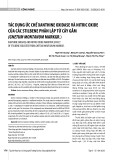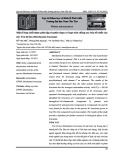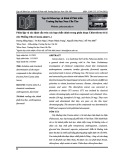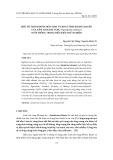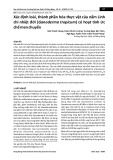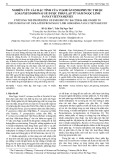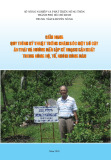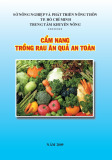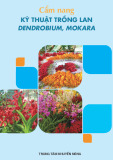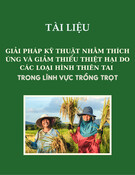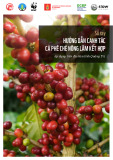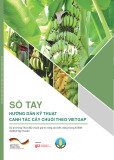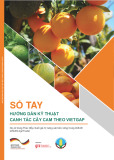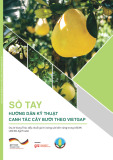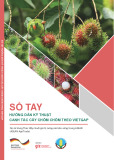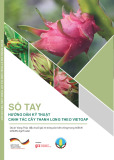
Vietnam Journal
of Agricultural
Sciences
ISSN 2588-1299
VJAS 2024; 7(1): 2030-2039
https://doi.org/10.31817/vjas.2024.7.1.02
https://vjas.vnua.edu.vn/
2030
Received: November 1, 2023
Accepted: March 26, 2024
Correspondence to
giahuybtvt@gmail.com
Study on the Population and Composition of
Parasitic Nematodes related to Da Xanh
Pomelo (Citrus maxima) in Tien Giang
Province, Vietnam
Nguyen Gia Huy*, Tran Thi Thu Tram, Dang Thi Kim Uyen &
Nguyen Van Hoa
Department of Plant Protection, Southern Horticultural Research Institute, Tien Giang
860000, Vietnam
Abstract
Da Xanh pomelo (Citrus maxima) is a fruit tree with many nutrients
and high economic value. However, nematode attacks are one of the
factors that limit productivity. The aim of this study was to
investigate and identify the species composition of parasitic
nematodes on Da Xanh pomelos tree in the study area, thereby
assessing their prevalence and impact on the health and productivity
of the pomelo trees. Based on the approach of surveying gardens with
symptoms of yellow leaves and root rot, soil and root samples were
collected and analyzed. The results of surveying the composition of
plant parasitic nematodes in Tien Giang province (Cai Be, Cai Lay,
Cho Gao, Chau Thanh, and My Tho) discovered 11 genera belonging
to eight families of plant parasitic nematodes present in the soil and
root zone of Da Xanh pomelo trees. Thus, ten nematode species were
identified, namely Aphelenchus avenae, Criconemella onoensis,
Helicotylenchus crenacauda, H. digonicus, Pratylenchus coffeae,
Rotylenchulus reniformis, Tylenchorhynchus leviterminalis,
Tylenchulus semipenetrans, Xiphinema insigne, and X.
longicaudatum. The species T. semipenetrans appeared at 80% and
76.67% in the soil and root samples, respectively, thus marking it as
an important species that needs to be controlled. P. coffeae and R.
reniformis were dominant in roots and should be of concern as
populations increase. The results of this study provide scientific data
to assist in carrying out measures to control nematodes on Da Xanh
pomelo trees.
Keywords
Da Xanh pomelo, Pratylenchus coffeae, plant parasitic nematodes,
Rotylenchulus reniformis, Tylenchulus semipenetrans.
Introduction
Citrus fruit trees lead the world in terms of cultivated area and
yield and are grown mainly in tropical and subtropical areas. Tien

Nguyen Gia Huy et al. (2024)
https://vjas.vnua.edu.vn/
2031
Giang province is a place with highly effective
cultivation and intensive farming conditions for
this crop. In particular, Da Xanh pomelo is a crop
that brings high economic value to farmers and
has great export potential. In 2015, Tien Giang
province had nearly 5,200 hectares of pomelo,
especially Da Xanh pomelo, with an annual harvest
of over 91,000 tons of fruit to supply the domestic
and export markets (Department of Statistics of
Tien Giang province, 2022). However, this growth
is threatened by various factors, such as natural
disasters, climate change, and infestation by
various organisms such as insects, fungi, and
nematodes, with nematodes being the pest of
greatest concern. According to previous studies,
depending on the level of infection, yield
reductions can range from 10% to 30% (Duncan &
Cohn, 1990). Mature plants can withstand large
numbers of nematodes before showing a lack of
vigor, and typical symptoms caused by plant-
parasitic nematodes include stunted and slow
growth, yellowing of leaves, reduced foliage,
increased fruit drop rate, decreased fruit size, and a
reduction in yield (Duncan, 2009). In addition,
infection by nematodes increases the level of
enzymes that damage root cells, causes peeling of
the shell in severe infections, and increases in
secondary pathogen infections (Hamid et al., 1989;
Abd-Elgawad et al., 2015). The level of damage
caused by nematodes on pomelo trees is receiving
more and more attention. At the same time, there is
still no research on the composition of plant-
parasitic nematodes on Da Xanh pomelo.
Therefore, the need for additional surveys and
updated assessments to clarify the presence of
nematodes and species related to Da Xanh
pomelo in Tien Giang province is an urgent issue.
As such, there were three main goals for this
research. First, determine the composition and
density of the parasitic nematode community of Da
Xanh pomelo in Tien Giang province. Second,
identify important genera/species of harmful
nematodes on Da Xanh pomelo trees in Tien Giang
province. Third, evaluate the distribution of
nematodes among the surveyed areas.
Materials and Methods
Research subjects
The objective of this research was to identify
and assess plant parasitic nematodes on Da Xanh
pomelo. The research location consisted of five
concentrated cultivation districts of Da Xanh
pomelo, namely Cai Be, Cai Lay, Cho Gao, Chau
Thanh, and My Tho city, in Tien Giang province.
Thirty total samples were collected and each total
sample included one soil sample (500g) and one
root sample (5g). The number of survey samples
was divided equally among each distribution
area. All analyses were conducted at the
laboratory and net house of the Department of
Plant Protection at the Southern Fruit Institute.
Research methods
Sampling, nematode identification and
population analysis
The 5-point cross-angle method or zigzag
sampling method was used, depending on the
terrain, to have a suitable collection method.
First, the topsoil was removed and the soil was
dug to a depth of 25-30cm. After that, 1,000g was
collected from the soil locations where plants had
symptoms of yellow leaves, small fruits, and root
rot, and 10g of roots with symptoms of loose root
bark due to rot was collected from the wood.
Then, the collected samples were put in sample
bags and transported to the laboratory for
analysis (Bezooijen, 2006; Ravichandra, 2010).
Extracting, fixing and mounting nematodes
Nematodes were recovered from the soil
samples according to the modified Bearmann
tray method (as described by Barker, 1985) and
recovered from root samples based on the
methods of Hooper et al. (2005). The
nematodes were fixed in hot FA solution
following Seinhorst (1966). Nematode
specimens were processed to pure glycerol and
mounted on permanent slides using Hooper
(1986) with adjustments.
Evaluation methods
Morphological characteristics were mainly
based on body shape and important taxonomical
characteristics such as head, lip region, stylet,
base, esophageal gland, intestines, ovary, uterus,
cloaca, and tail shape. The classification system
of Siddiqi (2000) combined with references to
information in the classification key of Nguyen
Ngoc Chau & Nguyen Vu Thanh (2000) was
used to identify the nematodes.

Study on the population and composition of parasitic nematodoes related to Da Xanh pomelo in Tien Giang province
2032
Vietnam Journal of Agricultural Sciences
Nematode morphological measurements
were expressed through de Man's index (Hooper,
1986), which is mainly used for the identification
of nematodes of the order Tylenchida.
The mean density, absolute frequency,
relative frequency, and dominance value index
were calculated according to Norton (1978)
(cited by Chen et al., 2012):
1. Absolute frequency (AF)
AF (%) =Number of samples containing genuses
Total number of samples collected ×100
2. Relative frequency (RF)
RF (%) =Absolute frequency of a genuses (AF)
Sum of frequency of all genuses ×100
3. Mean population density
Nsample= (Vtotal x ncount)/ Vcount
(Each sample was counted three times and
then averaged.)
4. Prominence value (PV)
PV = Density × √Frequency
5. Percentage of individuals present
Percentage of individuals present (%) =
The total number of nematodes present in a genus
The total number of nematodes present in the community×100
Data analysis
Data were processed using Microsoft
Office Excel 2016 software to calculate the
averages and statistical analyses were
conducted using SPSS version 26 software
using the Kruskal-Wallis post hoc test through
LSD classification at the 5% significance level.
Data were converted to log(x+1). Additionally,
the assessment was based on the formulas
described in the methods section.
Results
Characteristics of parasitic nematodes related
to Da Xanh pomelo trees in soil samples from
Tien Giang province
As the obtained results in Figure 1 show, 11
genera of plant-parasitic nematodes related to the
roots and rhizosphere of Da Xanh pomelo trees were
identified, namely Aphelenchus, Criconemella,
Discocriconemella, Helicotylenchus, Meloidogyne,
Pratylenchus, Rotylenchulus, Rotylenchus,
Tylenchorhynchus, Tylenchulus, and Xiphinema. Of
these, one genus (Xiphinema) belonged to the
Dorylaimida order, and the remaining ten genera
came from the Tylenchida order based on the
systems of Siddiqi (2000); Nguyen Ngoc Chau &
Nguyen Vu Thanh (2000).
As shown in Figure 1, the AFs of the genera
Tylenchulus and Rotylenchulus in the soil
samples accounted for 80%, which were higher
than Tylenchorhynchus (63.33%), Pratylenchus
(53.33%), Helicotylenchus (36.67%), Xiphinema
(16.67%), Meloidogyne (6.67%), and
Rotylenchus and Discoccriconemella, each with
the lowest absolute frequency of 3.33%.
Regarding relative frequency (RF),
Tylenchulus and Rotylenchulus both reached
17.91%, followed by Pratylenchus (11.94%),
and the remaining genera had a lower presence.
This shows that when high encounter frequency
(AF) also leads to high relative frequency (RF),
the presence of nematode genera plays an even
more important role.
Table 1 shows that the average population
density of the Tylenchulus genus was 1323.11 ±
575.86, a statistical difference at the 1%
significance level compared to the remaining
genera, of which the survey sample recorded the
population of this genus reaching 13,333
individuals/500g of soil. Moreover, the
dominance value of Tylenchulus reached
1183.43, higher than the other genera, showing a
special interaction between this genus and Da
Xanh pomelo trees.
Similarly, the average population
(nematodes/500g of soil) and prominence values
(PVs) of the Rotylenchulus and Pratylenchus
genera were 156.22 ± 52.81 and 139.73, and
217.68 ± 48.81 and 158.97, respectively.
However, the AF of Rotylenchulus reached 80%
and that of Pratylenchus was 53.33%, showing
that although the presence of Pratylenchus was
lower than that of Rotylenchulus, the
establishment of population biomass of this
genus was more effective than that of
Rotylenchulus, and also Tylenchorhynchus (AF
= 63.33%). The remaining genera, which had
no statistically significant differences in
density, mean population density, or AFs at
medium and low levels, were considered
secondary genera in the Da Xanh pomelo
parasitic nematode community.

Nguyen Gia Huy et al. (2024)
https://vjas.vnua.edu.vn/
2033
Figure 1. Absolute frequencies (AF) and relative frequencies (RF) of Da Xanh pomelo parasitic nematode components in soil
samples (500g) from Tien Giang province (Unit: %)
Table 1. Composition of parasitic nematodes of Da Xanh pomelo trees in soil samples (500g) from Tien Giang province
Ordinal
Nematode genera
MPD ± SE1
Low-High
Prominence value (PV)
1
Aphelenchus
87.33b ± 19.65
0-580
85.87
2
Criconemella
4.22b ± 3.79
0-113
1.09
3
Discocriconemella
2.67b ± 2.67
0-80
0.49
4
Helicotylenchus
24.89b ± 8.47
0-160
15.07
5
Meloidogyne
2.89b ± 2.67
0-80
0.75
6
Pratylenchus
217.68b ± 48.81
0-840
158.97
7
Rotylenchulus
156.22b ± 52.81
0-1340
139.73
8
Rotylenchus
1.33b ± 1.33
0-40
0.24
9
Tylenchorhynchus
96.00b ± 24.43
0-460
76.40
10
Tylenchulus
1323.11a ± 575.86
0-13333
1183.43
11
Xiphinema
7.11b ± 3.38
0-67
2.90
P-value
**
Note: Values in the same column with the same superscript are not significantly different at P ≤0.01. **: Significantly different at P
≤0.01. 1Mean population density ± standard error (nematodes/500g of soil).
Composition of parasitic nematodes related to
Da Xanh pomelo in root samples from Tien
Giang province
As shown in Figure 2, the AFs of
Tylenchulus and Rotylenchulus were 76.67%,
which were higher than the remaining genera of
Pratylenchus (56.67%), Tylenchorhynchus
(40%), and Helicotylenchus (26.67%). The RF
also show the presence of the Tylenchulus genus
having a frequency 38.41% higher than the other
genera. However, the Pratylenchus genus, which
reached 20.48%, had a relatively higher
frequency than Rotylenchulus, although the AF
of this genus was smaller than Rotylenchulus.
The data in Table 2 show that there were five
genera of parasitic nematodes on the roots

Study on the population and composition of parasitic nematodoes related to Da Xanh pomelo in Tien Giang province
2034
Vietnam Journal of Agricultural Sciences
Figure 2. Absolute frequencies (AF) and relative frequencies (RF) of Da Xanh pomelo parasitic nematode components in root
samples (5g) from Tien Giang province (Unit: %)
Table 2. Composition of parasitic nematodes of Da Xanh pomelo trees in root samples (5 g) from Tien Giang province
Ordinal
Nematode genera
MPD ± SE1
Low-High
Prominence value (PV)
1
Pratylenchus
133.79b ± 29.87
0-540
100.72
2
Tylenchulus
221.11a ± 101.03
0-2600
193.61
3
Tylenchorhynchus
33.11c ± 11.48
0-233
20.94
4
Helicotylenchus
18.89c ± 9.06
0-240
9.76
5
Rotylenchulus
41.78c ± 11.93
0-413
36.58
P-value
**
Note: Values in the same column with the same supercript are not significantly different at P ≤0.01. **: Significantly different at P
≤0.01. 1Mean population density ± standard error (nematodes/5g of root).
(nematodes/5g) of Da Xanh pomelo trees in Tien
Giang province. The population of the
Tylenchulus genus reached the highest at 221.11
± 101.03, a statistical difference at the 1%
significance level compared to the remaining
genera, followed by the Pratylenchus genus
reaching 133.79 ± 29.87 nematodes/5g of roots
and Rotylenchulus (semi-endoparasitic) reaching
41.78 ± 11.93 nematodes/5g of roots, with the
remaining two nematode genera
Tylenchorhynchus and Helicotylenchus
(ectoparasites) reaching 33.11 ± 11.48 and 18.89
± 9.06 individuals/5g of root, respectively. At the
same time, the prominence value for Tylenchulus
was 193.61, which showed that this genus was
more dominant in pomelo roots than the other
genera. Therefore, the data showed that
specifically in both the soil and root samples, the
close relationship among the high dominance
values also led to high survey densities and
frequencies, indicating that the above genera are
important parasitic agents causing damage to the
roots of Da Xanh pomelo trees.
Percentage of individuals present in the Da
Xanh pomelo parasitic nematode community
The pie chart in Figure 3 features the
percentage of individuals of each nematode
species present on Da Xanh pomelo trees and
shows that the Tylenchulus genus had the highest
percentage of individuals present, reaching
65.09% of the total number of nematodes in the
community. This was followed by Pratylenchus,
and although the AF was lower than some other
nematode genera, the number of individuals was
higher, specifically 14.82%. To complete the pie


